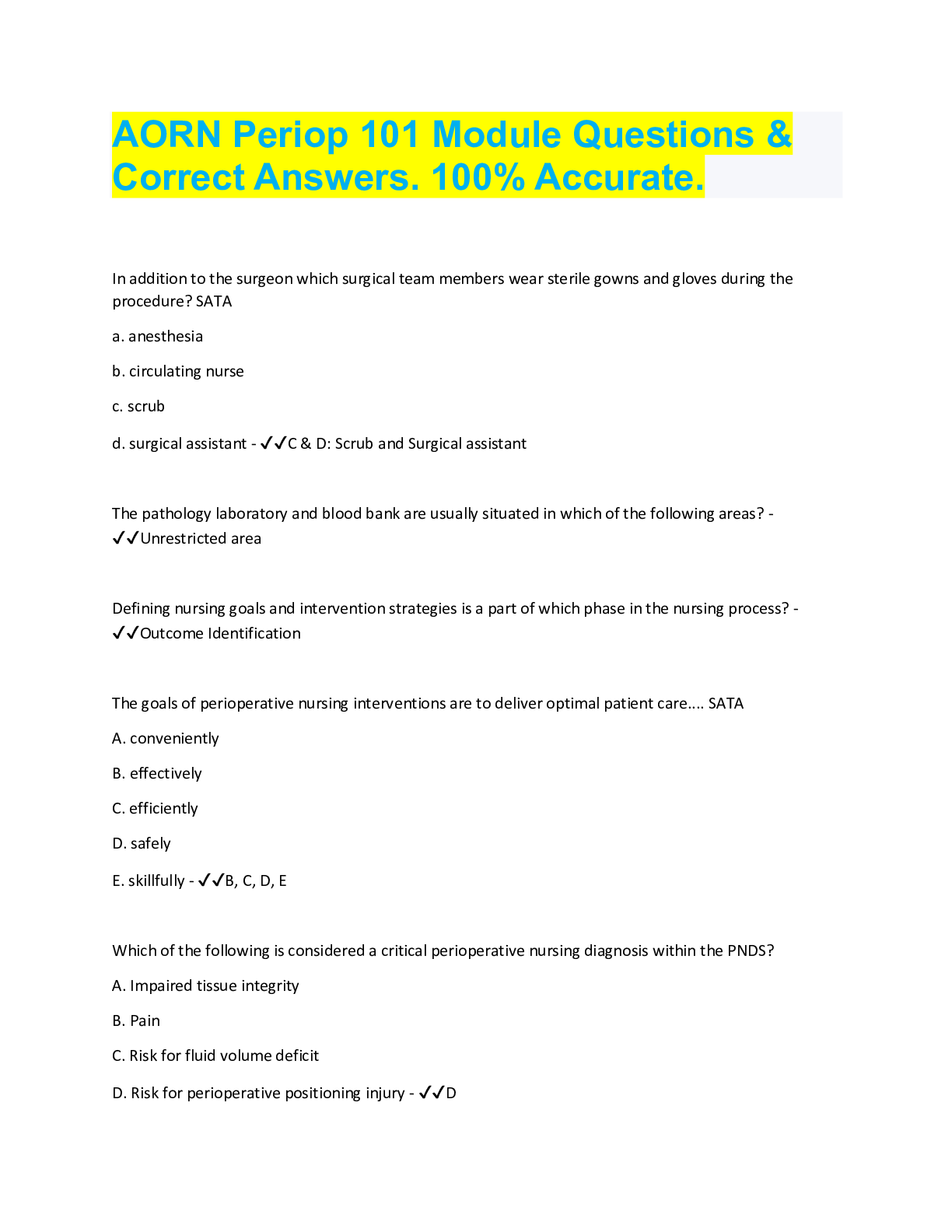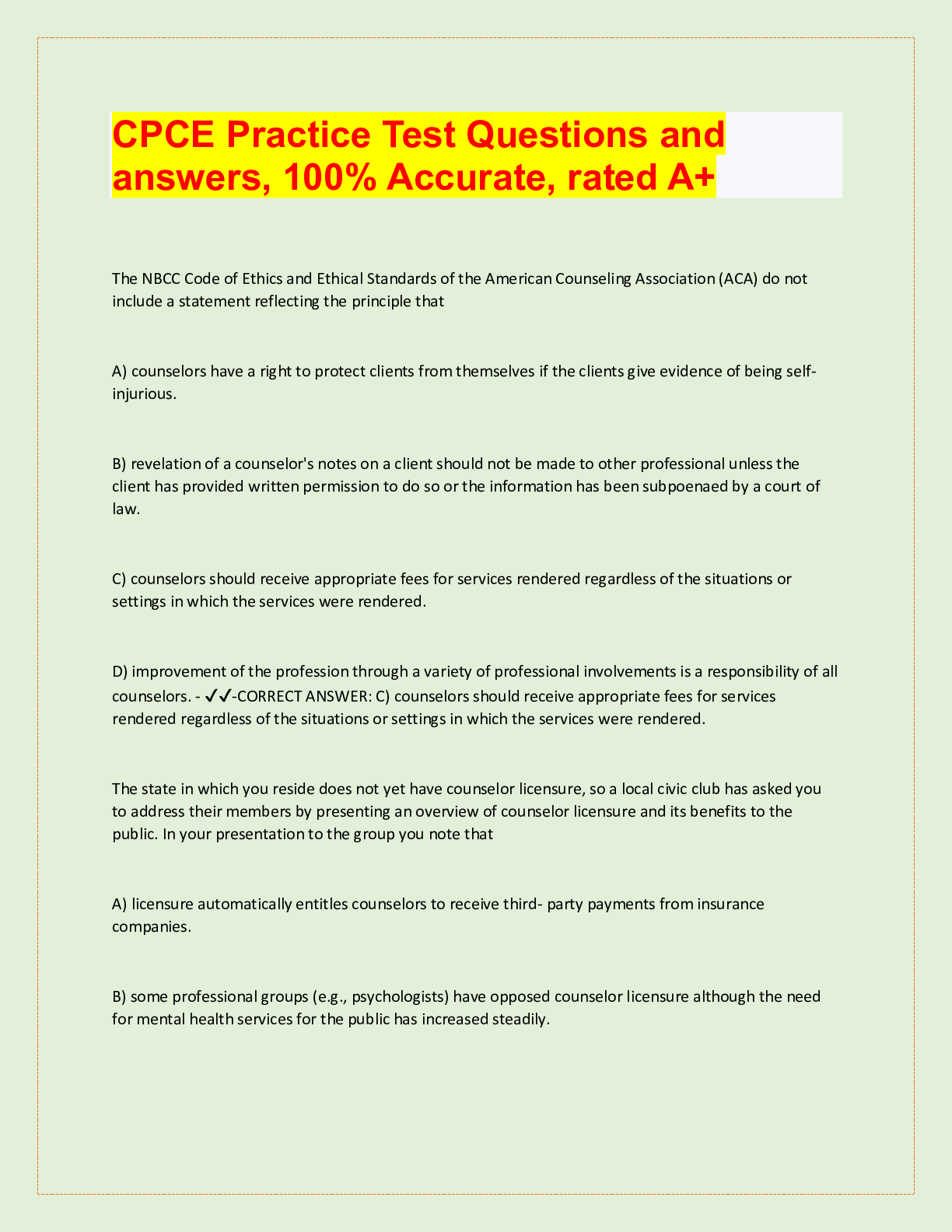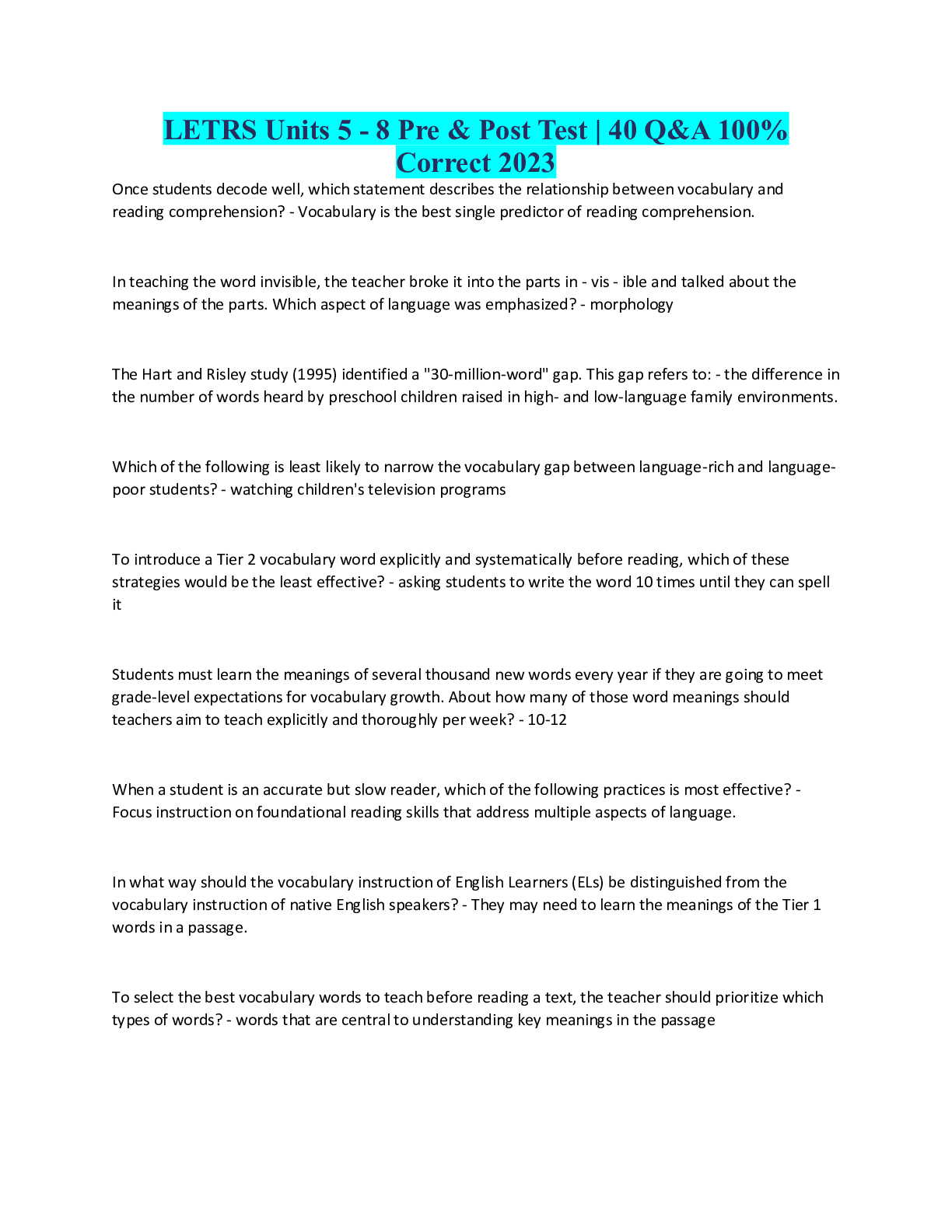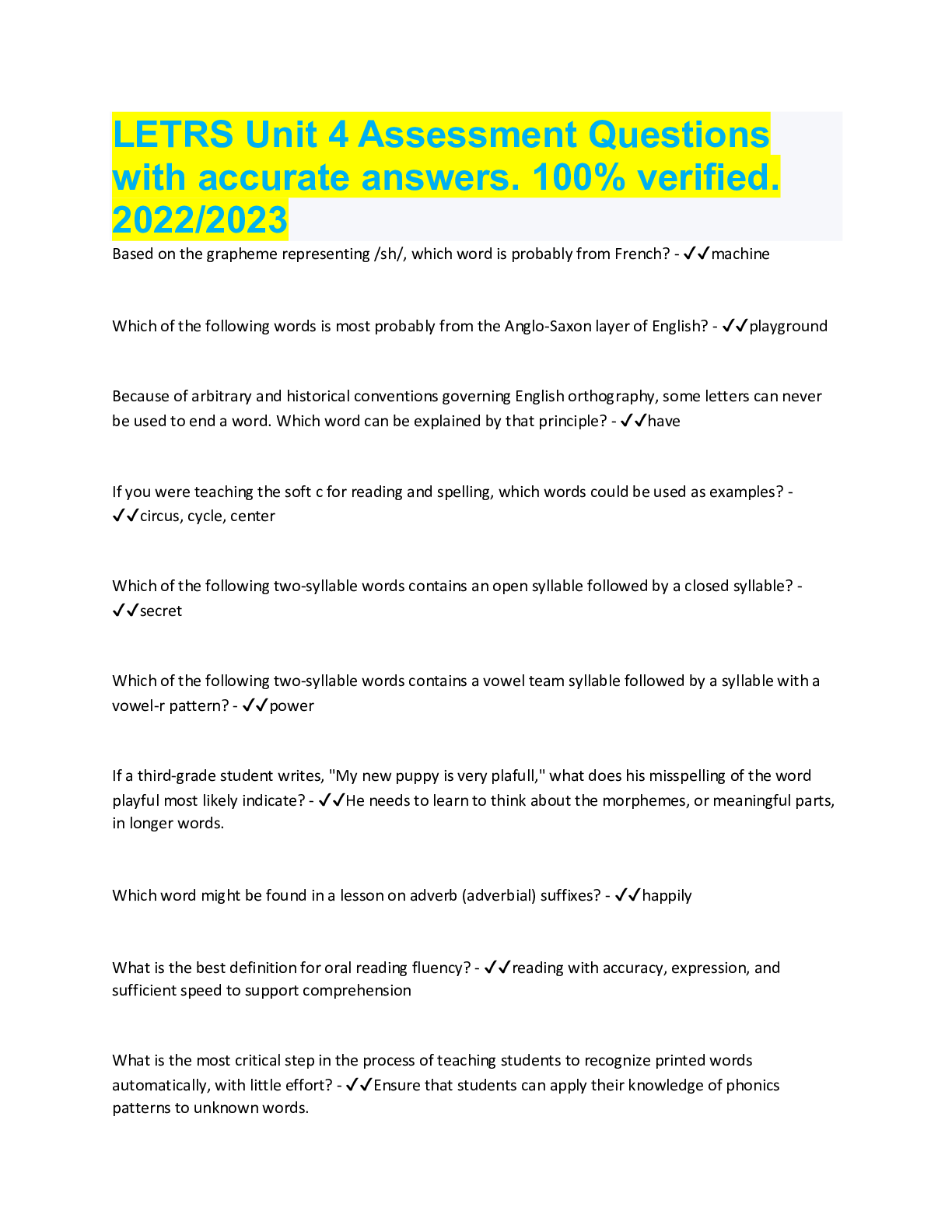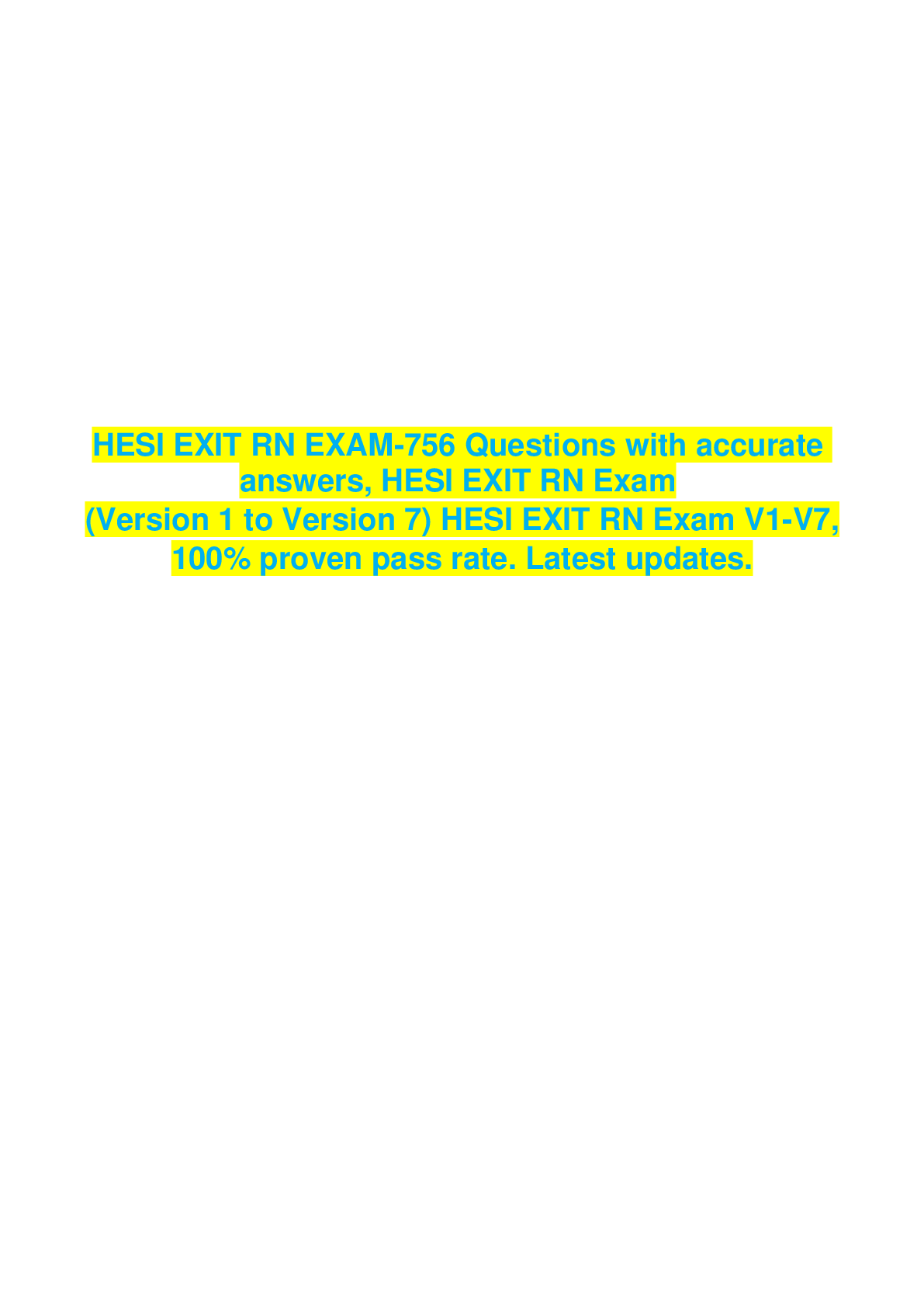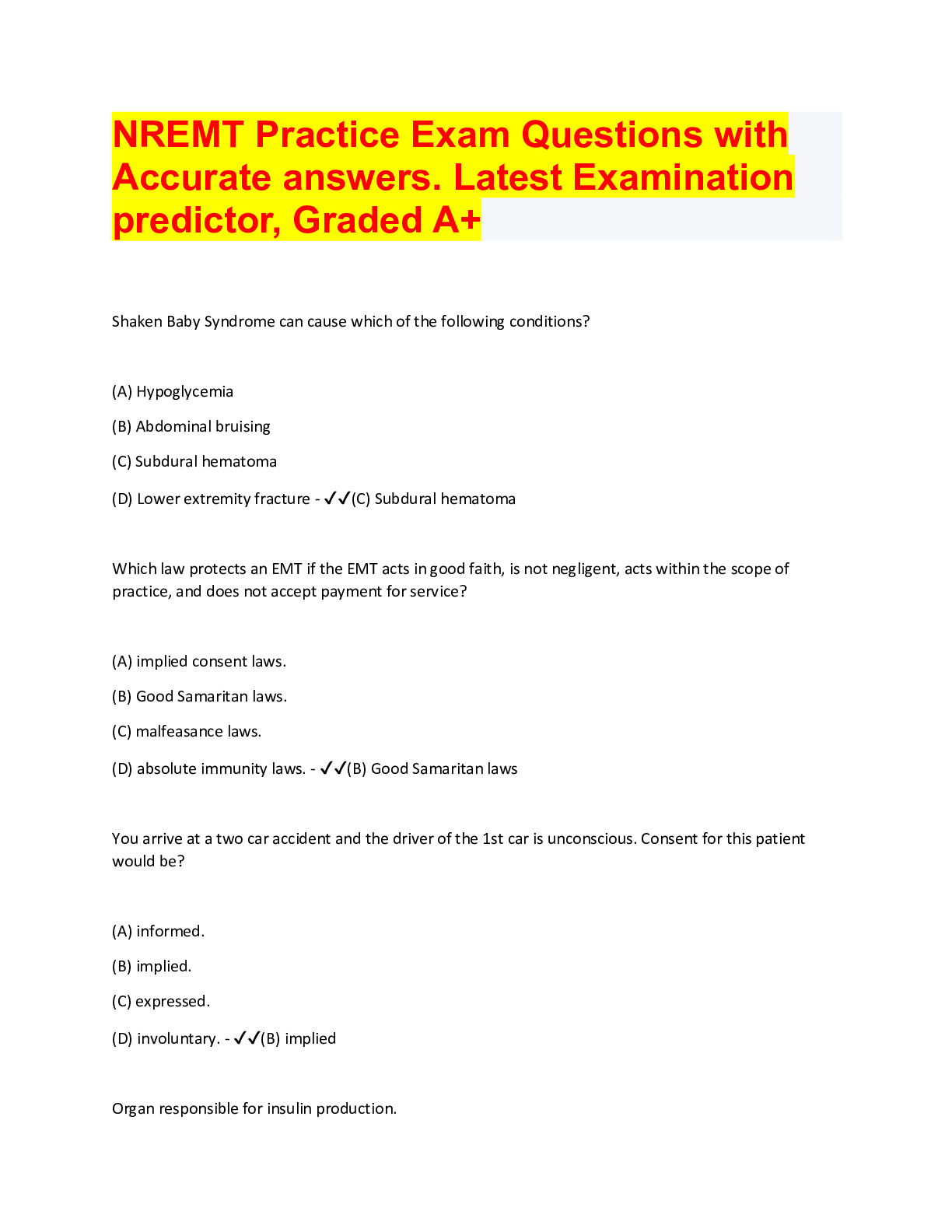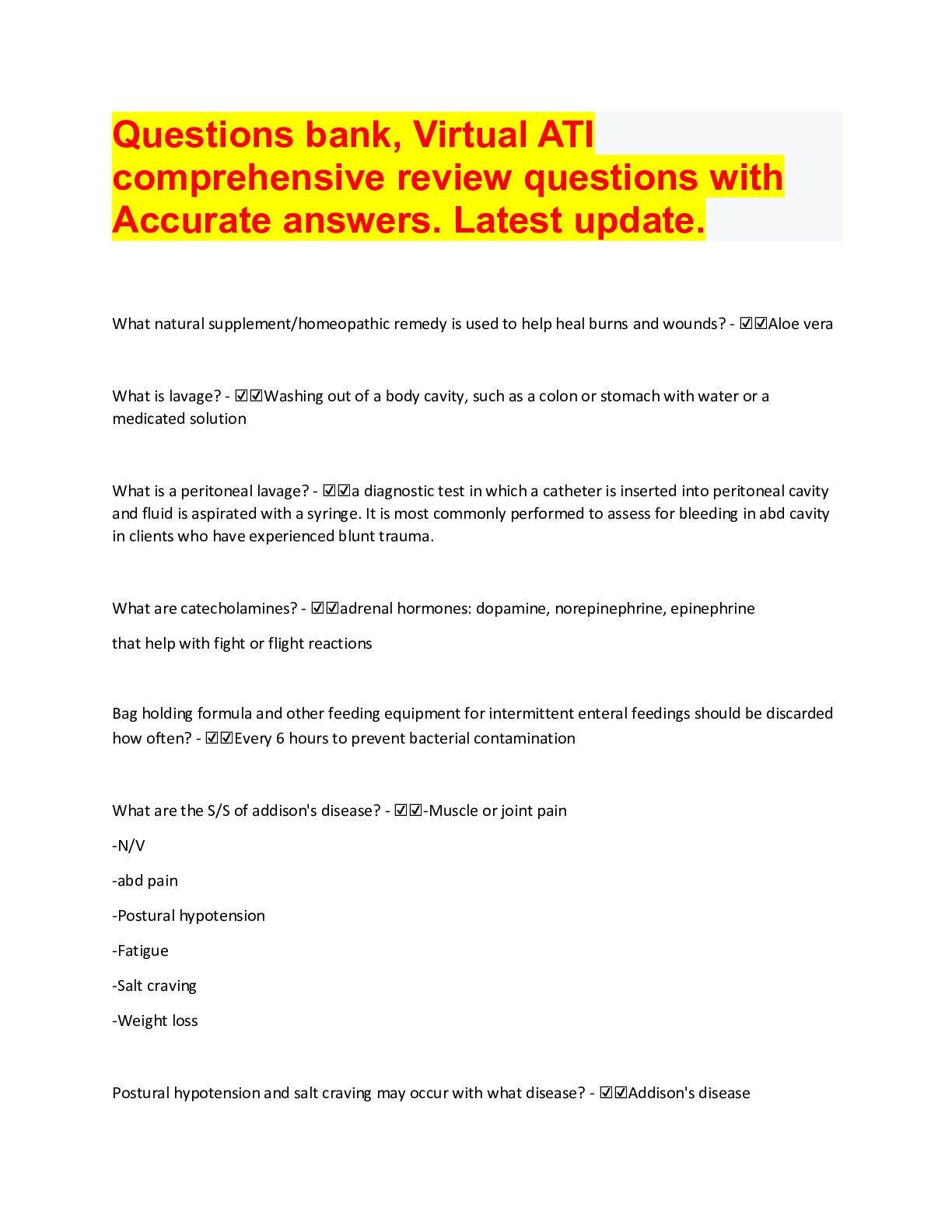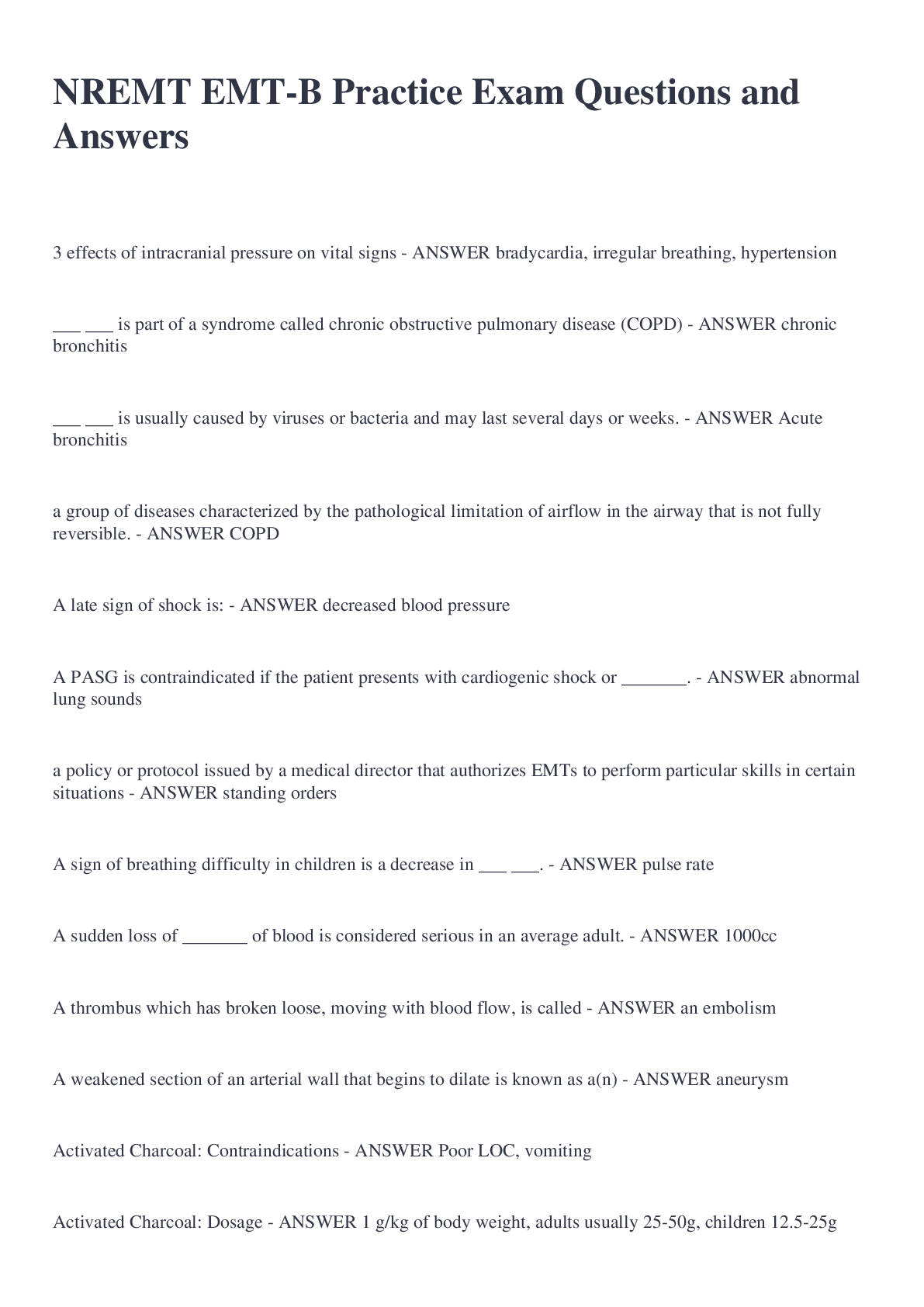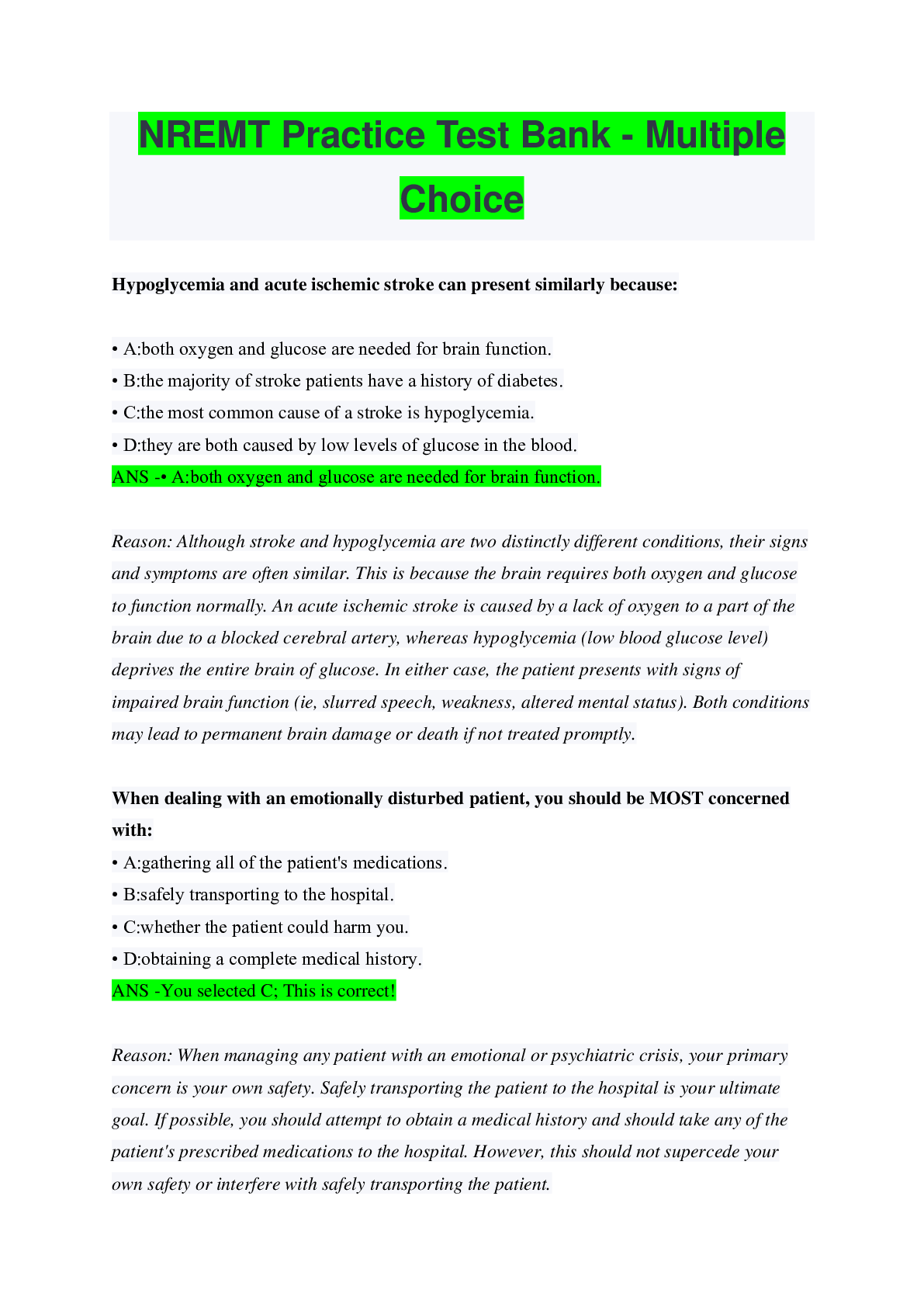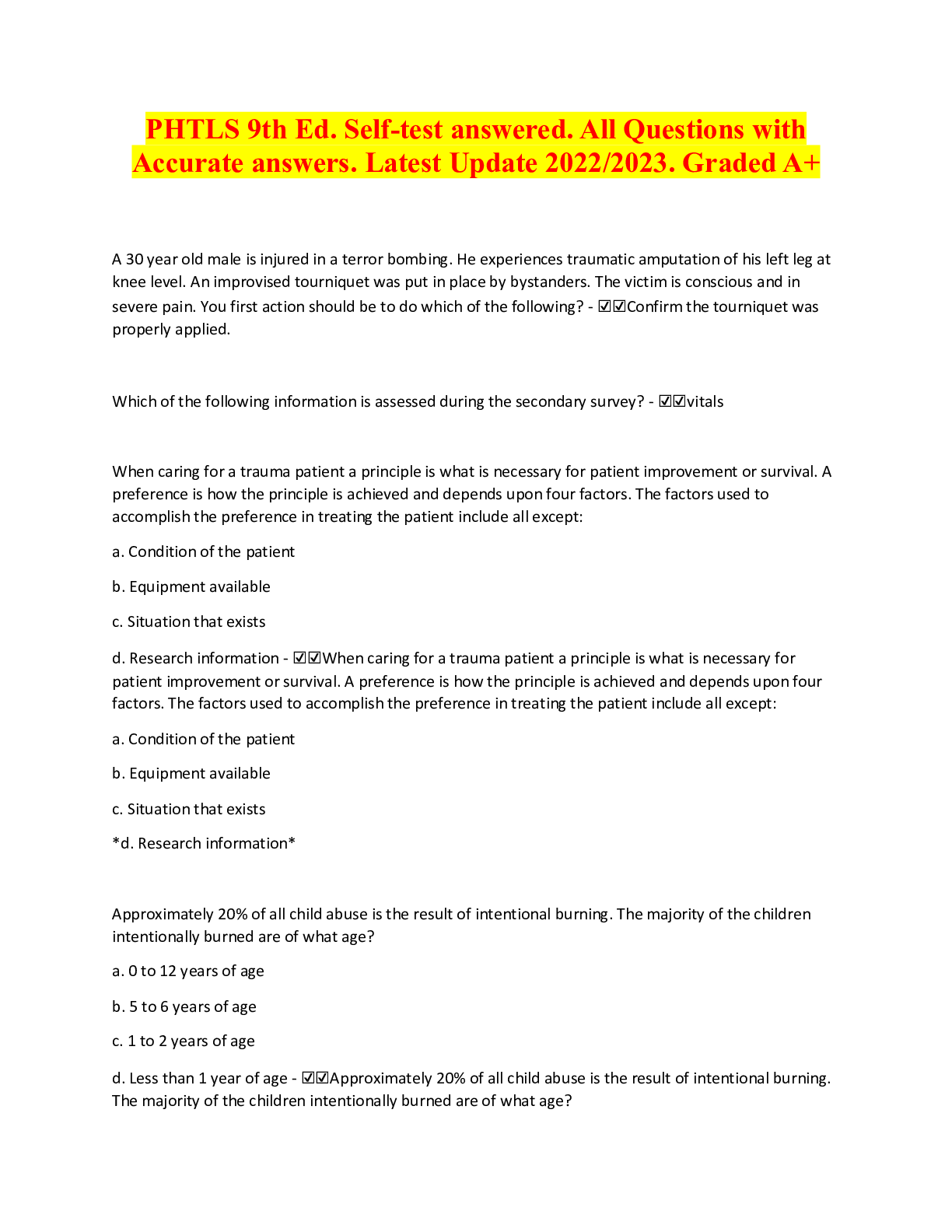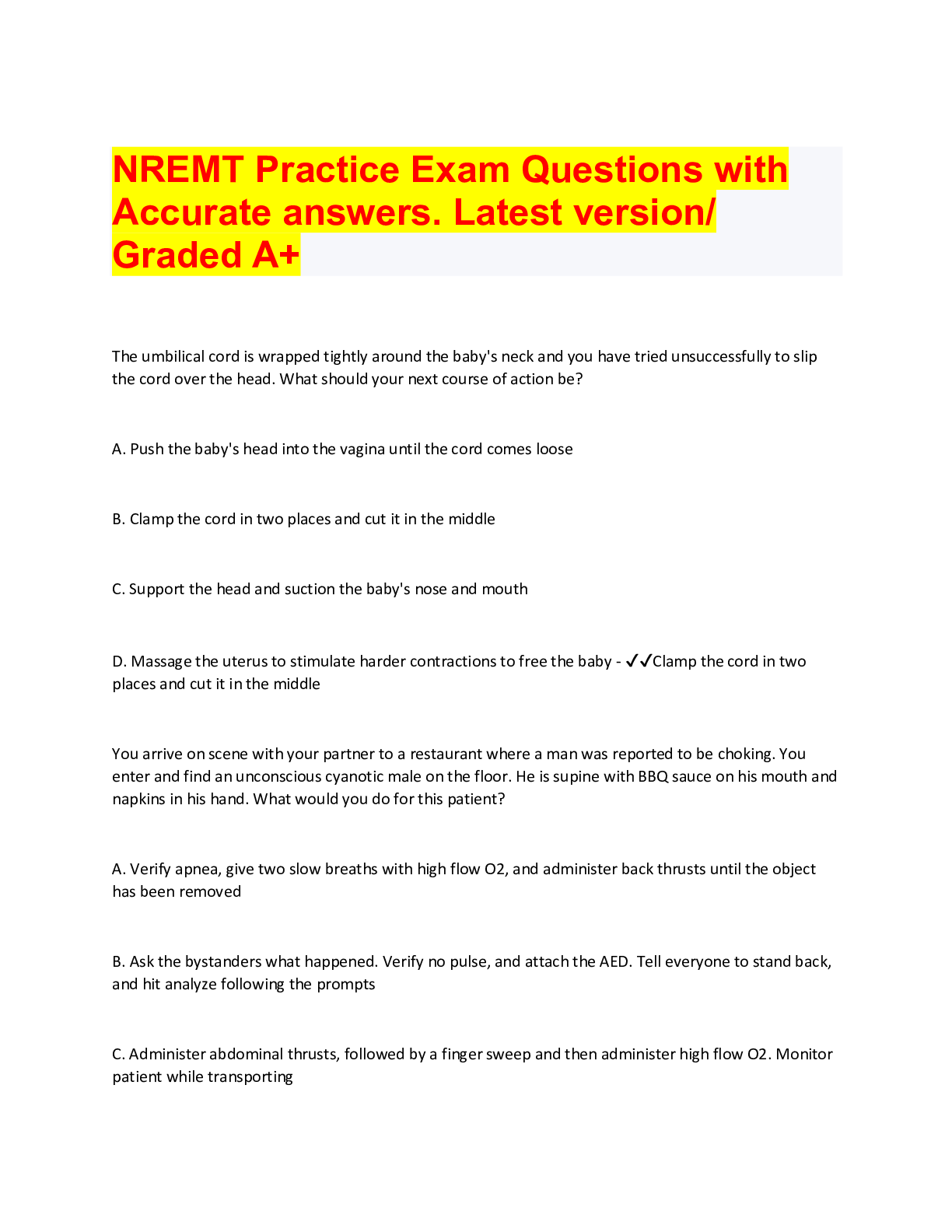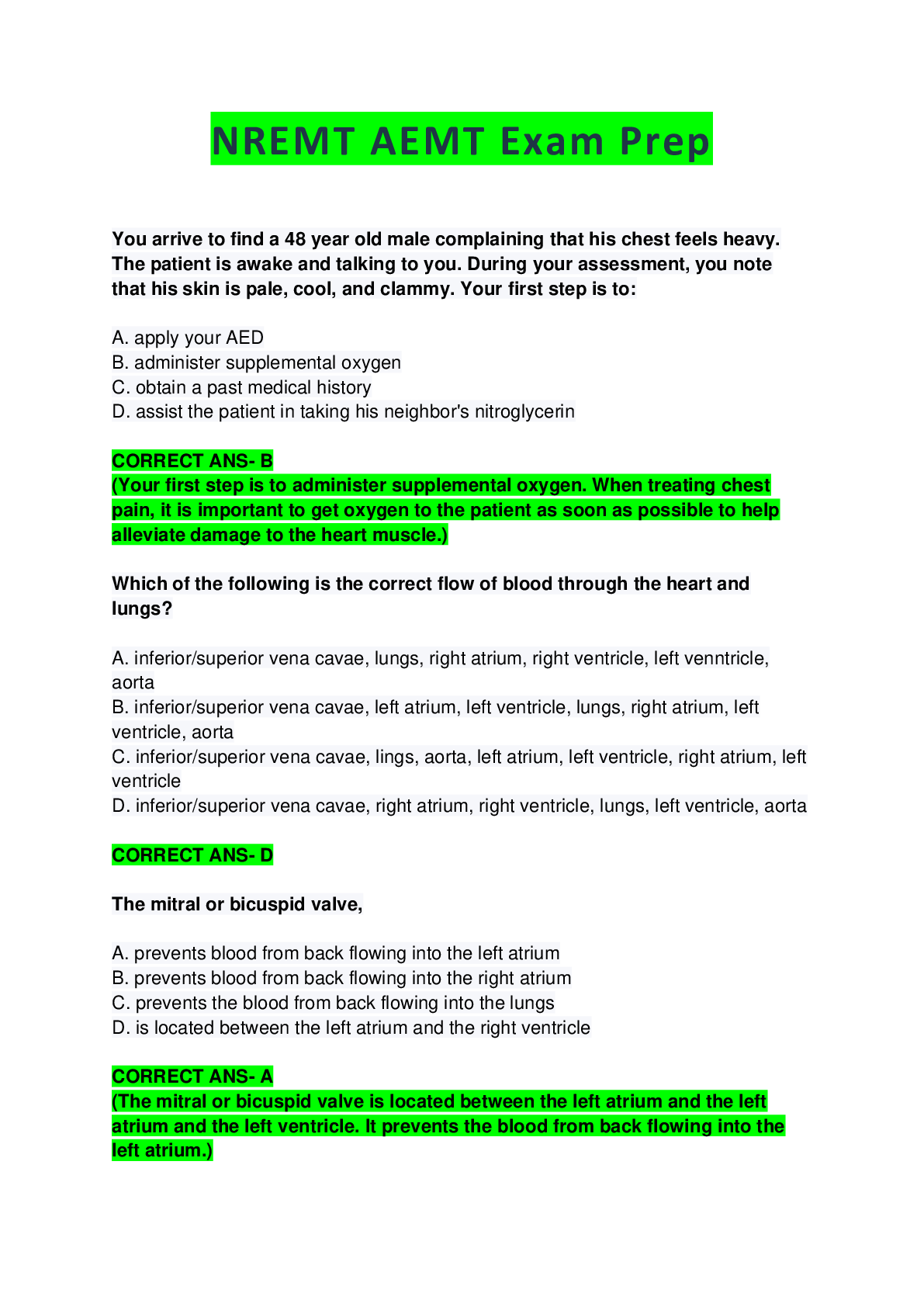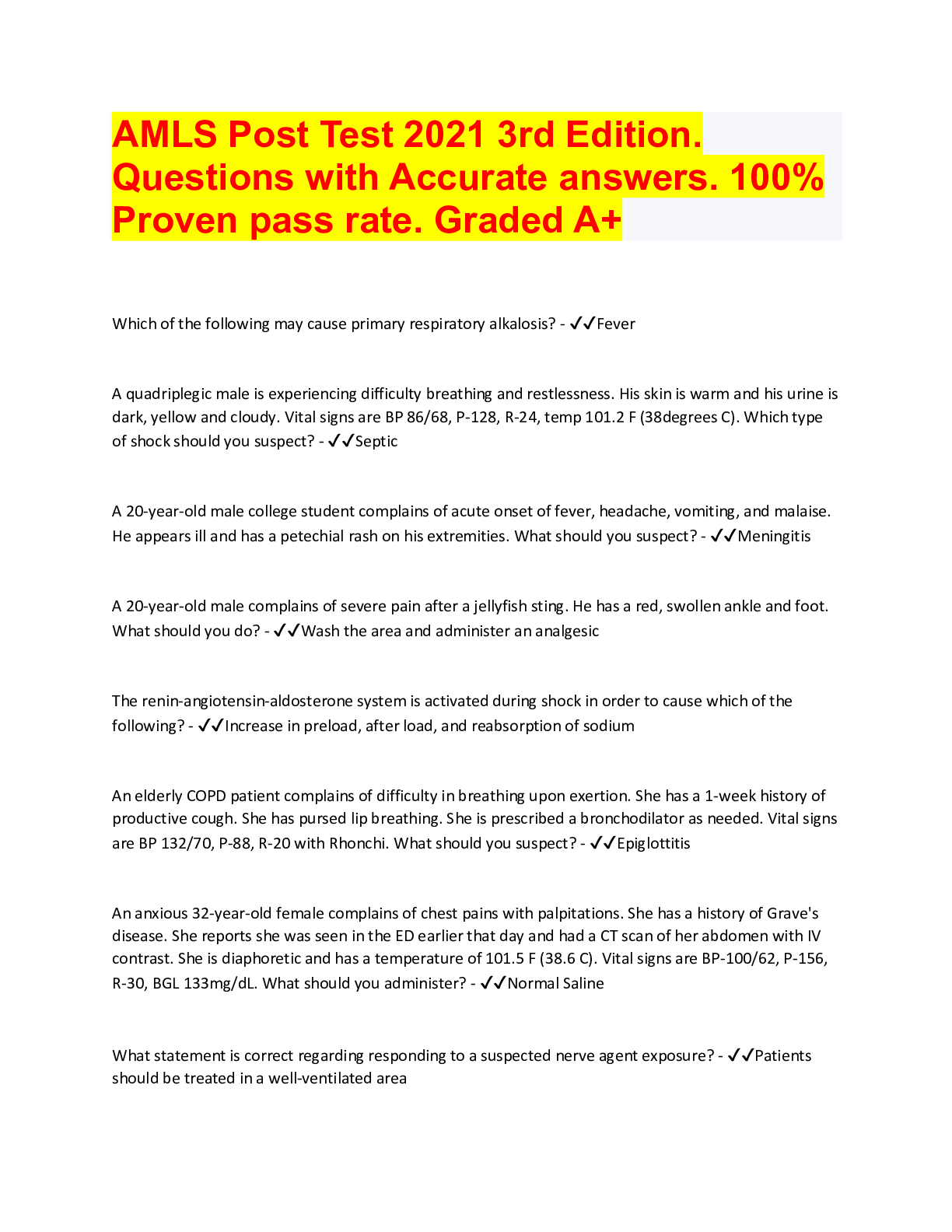*NURSING > QUESTIONS & ANSWERS > Intracranial Concept, Questions with accurate answers, Rated A, 2022/2023. (All)
Intracranial Concept, Questions with accurate answers, Rated A, 2022/2023.
Document Content and Description Below
Intracranial Concept, Questions with accurate answers, Rated A, 2022/2023. 1. The client is admitted to the emergency department after a fall from a roof. After determining that the client sustai... ned a head injury, the nurse observes clear fluid coming from the client's left ear. What will the nurse do next? A. Turn the client to the unaffected side B. Cleanse the client's ear with sterile gauze C. Place sterile cotton loosely in the external canal of the left ear D. Test the drainage from the client's ear with a glucose reagent strip - ✔✔Correct Answer: D If a basilar skull fracture has occurred, the cerebrospinal fluid (CSF) may drain through the client's ears or nose. This clear fluid may be tested with a glucose reagent strip; if the result is positive for glucose, then the fluid might be CSF. However, this test is not always reliable. 2. The parents of a school-aged child with fever, headache, and a stiff neck ask that the child be tested for meningitis. Which test should the nurse tell the parents is used to confirm the diagnosis of meningitis? A. Blood culture B. Lumbar puncture C. Meningomyelogram D. Peripheral skin smear - ✔✔Correct Answer: B A culture of cerebrospinal fluid (CSF), obtained through lumbar puncture, reveals the presence of the causative microorganism (e.g., Pneumococcus, tubercle bacillus, Meningococcus, Streptococcus). 3. The nurse assesses a 5-year-old child after a shunt procedure is performed to correct increased intracranial pressure. Which finding is of most concern? A.Marked irritability B.Complaints of pain C. Pulse of 100 beats/min D. Temperature of 99.4° F (37.4° F) - ✔✔Correct Answer: A Marked irritability may be a sign of malfunction of the shunt or infection and should be reported immediately. 4. A nurse is precepting an orientee (newly hired nurse). The nurse observes the orientee caring for an unconscious client with increasing intracranial pressure. The nurse should question which intervention that the orientee performs? A. Lubricating the skin with baby oil B. Suctioning the oropharynx routinely C. Elevating the head of the bed 20 degrees D. Cleansing the eyes every four hours with normal saline - ✔✔Correct Answer: B Although suctioning is done to maintain an airway, it is not done routinely because it increases intracranial pressure. 5. A nurse is caring for an infant with hydrocephalus after the insertion of a shunt. How should the nurse evaluate the effectiveness of the shunt? A.By palpating the anterior fontanel B. By determining the frequency of voiding C. By assessing the child for periorbital edema D. By assessing the symmetry of the Moro reflex - ✔✔Correct Answer: A A bulging fontanel is the most significant sign of increased intracranial pressure in an infant. 6. A client who sustained a severe head injury remains unconscious. During the client's assessment, the nurse observes bleeding from the left ear and rhinorrhea. The nurse concludes that drainage from the ear and nose indicates a: A. Contusion B. Concussion C. Nose fracture D. Basilar fracture - ✔✔Correct Answer: D A fracture at the base of the cranium can tear meninges, causing nasal leakage of cerebrospinal fluid (rhinorrhea) and bleeding from the ear. 7. The mother of a 7-year-old boy arrives at the emergency department with her son. The child reports that he hit his head after falling from his treehouse, and he says that he saw stars. Later he complains of a headache and feeling sick to his stomach. The nurse assesses his motor responses by evaluating his ability to: A. Draw a picture. B. Balance on one foot. C. Squeeze the nurse's hand. D. Walk slowly around the room - ✔✔Correct Answer: C Motor responses are tested by assessing the strength of the hand grasps, movement, and strength of the upper and lower extremities. 8. After a cerebrovascular accident (also known as brain attack) a client is unable to differentiate between heat or cold and sharp or dull sensory stimulation. What lobe of the brain should the nurse conclude is likely affected? A. Frontal B. Parietal C. Occipital D. Temporal - ✔✔Correct Answer: B Sensory impulses from temperature, touch, and pain travel via the spinothalamic pathway to the thalamus and then to the postcentral gyrus of the parietal lobe, the somatosensory area. -The frontal area is the area of abstract thinking and muscular movements. -The occipital area is the area where nerve impulses are translated into sight. -The temporal area is the area where nerve impulses are translated into sound. 9. The nurse, caring for a 3-year-old child with meningitis, should be alert for which signs and symptoms of increased intracranial pressure? Select all that apply. A. Vomiting B. Headache C. Irritability D. Tachypnea E. Hypotension - ✔✔Correct Answer: A,B,C Increased intracranial pressure can precipitate vomiting because of its effect on the chemoreceptor trigger zone in the medulla. Because the cranial sutures are closed by this age, increased pressure can cause headache. Irritability results from increased pressure in the cranium and as a response to related discomforts. 10. A 12-year-old child is admitted to the hospital for observation after sustaining a head injury. Twelve hours after the injury the child has none of the signs or symptoms of a head injury. What is the nurse's priority intervention at this time? A. Assessing the level of consciousness every hour B. Promoting rest by fostering a quiet environment C. Asking about the circumstances that led to the injury D. Administering the prescribed opioid for complaints of a headache - ✔✔Correct Answer: A Evidence of a subdural hemorrhage may take hours or days to develop; a diminishing level of consciousness is an early indication of neurological damage. 11. A client had spinal anesthesia for surgery. On the second day after surgery the client complains of a headache. How should the nurse respond? A. Begin an early ambulation program B. Encourage the client to drink 3 L of fluids in 24 hours C. Remove antiembolic stockings being worn D. Assist the client to sit at the bedside with the feet dangling - ✔✔Correct Answer: B Encouraging fluids will hydrate the client and contribute to the restoration of cerebrospinal fluid, which cushions the brain; this should ease the pain. The client should be maintained on bed rest and kept quiet. Strict bed rest for 24 to 48 hours may be recommended. 12. A nurse is performing a neurological assessment of a client. Which equipment is required when preparing to assess the vagus nerve (cranial nerve X) of a client? A. Tuning fork B. Ophthalmoscope C. Tongue depressor D. Cotton and a straight pin - ✔✔Correct Answer: C A tongue depressor is used to depress the tongue to observe the pharynx and larynx, and to assess soft palate symmetry and the presence of the gag reflex; the information obtained provides data about cranial nerve X (vagus). -A tuning fork is used to assess cranial nerve VIII (auditory). -An ophthalmoscope is used to assess cranial nerve II (optic). -Cotton and a straight pin are used to assess sensory function: light touch and pain. 13. A pregnant client with severe preeclampsia is receiving an infusion of magnesium sulfate. What does the nurse identify as the main reason that this medication is administered? A. It acts as a diuretic. B. It has a sedative effect. C. It acts as an anticonvulsant. D. It has an antihypertensive effect. - ✔✔Correct Answer: C The target tissue of magnesium sulfate is the myoneural junction; it decreases secretion of acetylcholine, thereby depressing neuromuscular transmission, which prevents seizures. 14. What is the primary concern for a nurse caring for a client who is grossly impaired by stimulants? A. Drowsiness B. Seizure activity C. Fluid imbalance D. Suicidal ideation - ✔✔Correct Answer: B Stimulants increase the excitatory neurotransmitters (e.g., adrenaline and dopamine), lowering the seizure threshold. A person who is under the heavy influence of stimulants will be unable to rest and sleep because of stimulation of the sympathetic nervous system. 15. A client arrives at the emergency department with neurological deficits after a motor vehicle accident. Using the Glasgow Coma Scale, the nurse assesses what client responses? Select all that apply. A. Pupil response to light B. Verbal response to speech C. Eye opening in response to speech D. Deep tendon reflexes in response to percussion E. Motor activity in response to a verbal command - ✔✔Correct Answer: B,C,E Assessing a client's verbal response to the nurse's speech is one of the three criteria for determining level of consciousness with the Glasgow Coma Scale. Assessing eye opening in response to the nurse's speech is one of the three criteria for assessing level of consciousness with the Glasgow Coma Scale. Assessing a client's motor response to a verbal command is one of the three criteria for assessing level of consciousness with the Glasgow Coma Scale. 16. A nurse is caring for a client who had a brain attack (cerebrovascular accident) two weeks ago. What should the nurse do to help the client develop independence? A. Establish long-range goals for the client. B. Reinforce success in tasks accomplished. C. Point out errors in performance on which to focus. D. Explain ways the client can regain independence in activities. - ✔✔Correct Answer: B To aid in motivation, the nurse should focus on positive aspects of the client's progress. Short-term, not long-term, attainable goals provide positive reinforcement; the nurse should assist the client to set goals. Negative reinforcement may result in discouragement. Return demonstration by the client is more effective than telling or showing what to do. 17. A client is admitted to the hospital after having a tonic-clonic seizure. The client has a two-year history of a seizure disorder, but the seizures have been well controlled by phenytoin (Dilantin) for the last six months. The client says to the nurse, "I am so upset. I didn't think I was going to have more seizures." Which is the best response by the nurse? A. "Did you forget to take your medication?" B. "You are worried about having more seizures?" C. "You must be under a lot of stress right now." D. "Don't be too concerned because your medication needs to be increased." - ✔✔Correct Answer: B The response "You are worried about having more seizures?" addresses the client's feelings and encourages communication. 18. A nurse in the pediatric clinic is assessing an infant who had a revision of a ventriculoperitoneal shunt. What clinical finding alerts the nurse that intracranial pressure has increased? A. Increased pulse rate B. Hypoactive reflexes C. Decreased blood pressure D. Tension of the anterior fontanel - ✔✔Correct Answer: D The anterior fontanel will be widened and tense because of the increased volume of cerebrospinal fluid. -The pulse rate will be decreased with increased intracranial pressure. -The reflexes will be hyperactive with increased intracranial pressure. -The blood pressure will be higher with increased intracranial pressure. 19. A client is admitted to the emergency department with a head injury. Assessment findings include restlessness, cool and damp skin, equal and reactive pupils, and the ability to move all extremities on command. A computed tomography (CT) scan shows a subdural hematoma. The nurse understands that this condition means there is: A. Fluid in the subdural space B. Blood in the subarachnoid space C. Fluid between the dura and the skull D. Blood between the dura mater and the arachnoid layer - ✔✔Correct Answer: D A subdural hematoma refers to blood between the dura mater and the arachnoid layer of the meninges. 20. An infant born with hydrocephalus is to be discharged after insertion of a ventriculoperitoneal shunt. Which common complication should the nurse instruct the parents to report if it occurs at home? A. Visibility of the sclerae above the irises B. Violent involuntary muscle contractions C. Excessive fluid accumulation in the abdomen D. Fever accompanied by decreased responsiveness - ✔✔Correct Answer: D Fever accompanied by decreased responsiveness is associated with infection. This is the greatest postoperative hazard for children with shunts for hydrocephalus. 21. A client is taking phenytoin (Dilantin) to treat clonic-tonic seizures. The client's phenytoin level is 16 mg/L. Which action should the nurse take? A. Hold the medication and notify the health care provider. B. Administer the next dose of the medication as prescribed. C. Hold the next dose and then resume administration as prescribed. D. Call the health care provider to obtain a prescription with an increased dose. - ✔✔Correct Answer: B Administering the next dose of the medication as prescribed is within therapeutic range of 10 to 20 mg/L; the nurse should administer the drug as prescribed. The phenytoin level is within the therapeutic range of 10 to 20 mg/L; there is no need to hold the dose and notify the health care provider. (Anticonvulsant) 22. A client with a head injury has been receiving dexamethasone (Decadron). The health care provider plans to reduce the dosage gradually and to continue a lower maintenance dosage. Which effect associated with the gradual dosage reduction of the drug should the nurse explain to the client? A. Builds glycogen stores in the muscles B. Produces antibodies by the immune system C. Allows the increased intracranial pressure to return to normal D. Promotes return of cortisone production by the adrenal glands - ✔✔Correct Answer: D Hormone therapy must be withdrawn slowly to allow the adrenal glands to adjust and resume production of their hormone. 23. After three months of rehabilitation after a craniotomy, a client continues to have motor speech difficulties. To promote the client's use of speech the nurse should: A. Support the client's efforts to communicate B. Correct verbal mistakes immediately C. Use simple words with short sentences D. Explain why the client is having difficulty speaking - ✔✔Correct Answer: A Recognition of effort is motivating. Correcting mistakes may decrease both self-esteem and motivation. 24. A client who had a cerebrovascular accident (CVA, also known as "brain attack") is starting to eat lunch. What client behavior indicates to the nurse that the client may be experiencing left hemianopsia? A. Asks to have food moved to the left side of the tray. B. Drops the coffee cup when trying to use the right hand. C. Ignores the food on the left side of the tray when eating. D. Complains about not being able to use the left arm to help eat. - ✔✔Correct Answer: C Clients with left hemianopsia cannot see whatever is in the left field [Show More]
Last updated: 1 year ago
Preview 1 out of 50 pages

Reviews( 0 )
Document information
Connected school, study & course
About the document
Uploaded On
Oct 05, 2022
Number of pages
50
Written in
Additional information
This document has been written for:
Uploaded
Oct 05, 2022
Downloads
0
Views
79






